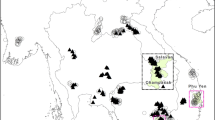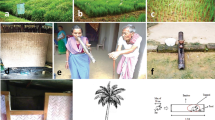Abstract
The paper presents a methodology that guided several ethnoentomological research projects and goes on to examine and compare the results from two independent research locations in Asia. The first location is in the Philippines, a Green Revolution area that has been heavily impacted by extension messages and insecticide use. The second location is in Nepal which has a traditional subsistence orientation and has remained widely unaffected by agricultural modernization. The paper emphasizes the differences and similarities of the results from the two sites and discusses the role of the methodology and methods used in capturing ethnoentomological knowledge, particularly with regard to insect pests in rice. The results of both investigations share the importance of agronomic criteria among farmers in insect classification and sorting criteria, thus highlighting the relevance of functional criteria. Farmers at both research sites have difficulties in identifying the lifecycles of insects. We discuss the issues of tradition and change in farmer entomological knowledge and providing support to the knowledge base of farmers though programs like IPM-Farmer Field Schools as opposed to broad-based recommendations for crop pest management.
Similar content being viewed by others
References
Bentley, J., (1992). Alternatives to pesticides in central America: Applied studies in local knowledge. Culture and Agriculture, 41, 10–13.
Bernard, R. H., (1994): Research methods in anthropology: Qualitative and quantitative approaches. Walnut Creek/London/New Delhi: Altamiar Press.
Björnsen Gurung, A. (2002). Indigenous Knowledge of Storage Pest Management in Nepal, Ph.D. Dissertaion, Department of Environmental Science, Swiss Federal Institute of Technology, 226␣pp.
Björnsen Gurung, A., (2003). Insects—a mistake in god’s creation? Tharu farmers’perception and␣knowledge of insects: A case study of gobardiha village development committee, Dang-Deukhuri, Nepal. Agriculture and Human Values, 20, 337–370.
Borgatti, S., (1992). Anthropac 4.0 methods guide. Columbia: Analytic Technologies.
Borgatti, S., (1996a). Anthropac 4.0 (software). Natick, Massachusetts: Analytical Technologies.
Borgatti, S., (1996b) Anthropac 4.0 reference manual. Natick, Massachusetts: Analytical Technologies.
Boster, J. S., (1994). The successive pilesort. Cultural Anthropology Methods, 6, 11–12.
Brewer, D., (1995). Cognitive indicators of knowledge in semantic domains. Journal of Quantitative Anthropology 5, 2, 107–128.
Brosius, P., Lovelace, G., & Martin, G., (1986). Ethnoecology: An approach to understanding traditional agricultural knowledge. In G. G. Martin (Ed.), Traditional agriculture in southeast Asia (pp. 187–198). Boulder/London: Westview Press.
Chelliah, S., & Bharathi, M., (1993). Insecticide-induced resurgence of insect pests of crop plants. In G. S. Dhaliwal, & B. Singh (Eds.), Pesticides: Their ecological impact in developing countries (pp. 51–80). New Delhi: Commonwealth Publishers.
Gardner, G., (1996). Preserving agricultural resources. In L. R. Brown (Eds.), State of the World 1996. New York: World Watch Institute and W. W. Norton and Company.
Heinrichs, E. A., & Mochida O., (1984). From secondary to major pest status: the case of insecticide induced rice brown planthopper, nilaparvata lugens, resurgence. Protection Ecology, 7, 201–218.
Johnson, S. C., (1967). Hierarchical clustering schemes. Psychometrika, 32, 241–253.
Kenmore, P. E., Carino, F. O., Perez, C. A., Dyck, V. A., & Gutierrez, A. P., (1984). Population regulation of the rice brown planthopper (Nilaparvata lugens Stal) within rice fields in the Philippines. Journal of Plant Protection in the Tropics, 1, 19–37.
Kenmore, P.E., (1991). Indonesia’s intergrated pest management program: A model for Asia. Manila, Philippines: FAO.
Pingali P., Roger A. (Eds.) (1995) Impact of pesticides on farmers health and the environment. Norwell, Massachusetts: Kluwer Academic Publishers.
Pingali, P., Hossain, M., & Gerpacio, R., (1997). AsianRrice bowls: The Rreturning crisis?. Wallingford, UK: CAB International (Published in association with the International Rice Research Institute, Philippines).
Pingali, P., Hossain, M., Pandy, S., & Price, L. L., (1998). Economics of nutrient management in asian rice systems: Towards increasing knowledge intensity. Field Crops Research, 56, 157–176.
Price, L. L., (2001): Demystifying farmers’entomological and pest management knowledge: A methodology for assessing the impacts on knowledge from IPM-FFS and NES interventions. Agriculture and Human Values, 18, 153–176.
Price, L. M. L., & Balasubramanian, V., (1998). Securing the future of intensive rice systems: A knowledge intensive resource management and technology approach. In N. G. Dowling, S. M. Greenfield, & K. S. Fischer (Eds.), Sustainability of rice in the global food system (pp. 88–98). Davis, California: Pacific Basin Study Center and Manila (Philippines): International Rice Research Institute.
Rola, A., & Pingali, P., (1993). Pesticides, rice productivity and farmers. Manila, Philippines: Health. International Rice Research Institute.
Romney, A. K., Weller, S. C., & Batcheleder, W. H., (1986). Culture as consensus: A theory of culture and informant accuracy. American Anthropologist, 88, 313–338.
Röling, N., & Jiggens, J., (1998). The ecological knowledge system. In N. G. Röling, & M. A. E. Wagemakers (Eds.), Facilitating sustainable agriculture: Participatory learning and adaptive management in times of environmental uncertainty. Cambridge, UK: Cambridge University Press.
Sherwood, S. G., (1997). Little things mean a lot: Working with central american farmers to address the mystery of plant disease. Agriculture and Human Values, 14, 181–189.
Smith, J. J., (1993). Using ANTHROPAC 3.5 and a spreadsheet to compute a free-list salience index. Cultural Anthropology Methods 5, 1–3.
Author information
Authors and Affiliations
Corresponding author
Additional information
Article type: MS-ENVI-SI ETHNOSCI MS04 Contribution to Environment, Development & Sustainability, special issue ‘Bridging the gap between natural resources and their human management for the future using ethnoscience’.
Rights and permissions
About this article
Cite this article
Price, L.L., Björnsen Gurung, A. Describing and measuring ethno-entomological knowledge of rice pests: tradition and change among Asian rice farmers. Environ Dev Sustain 8, 507–517 (2006). https://doi.org/10.1007/s10668-006-9052-5
Received:
Accepted:
Published:
Issue Date:
DOI: https://doi.org/10.1007/s10668-006-9052-5




